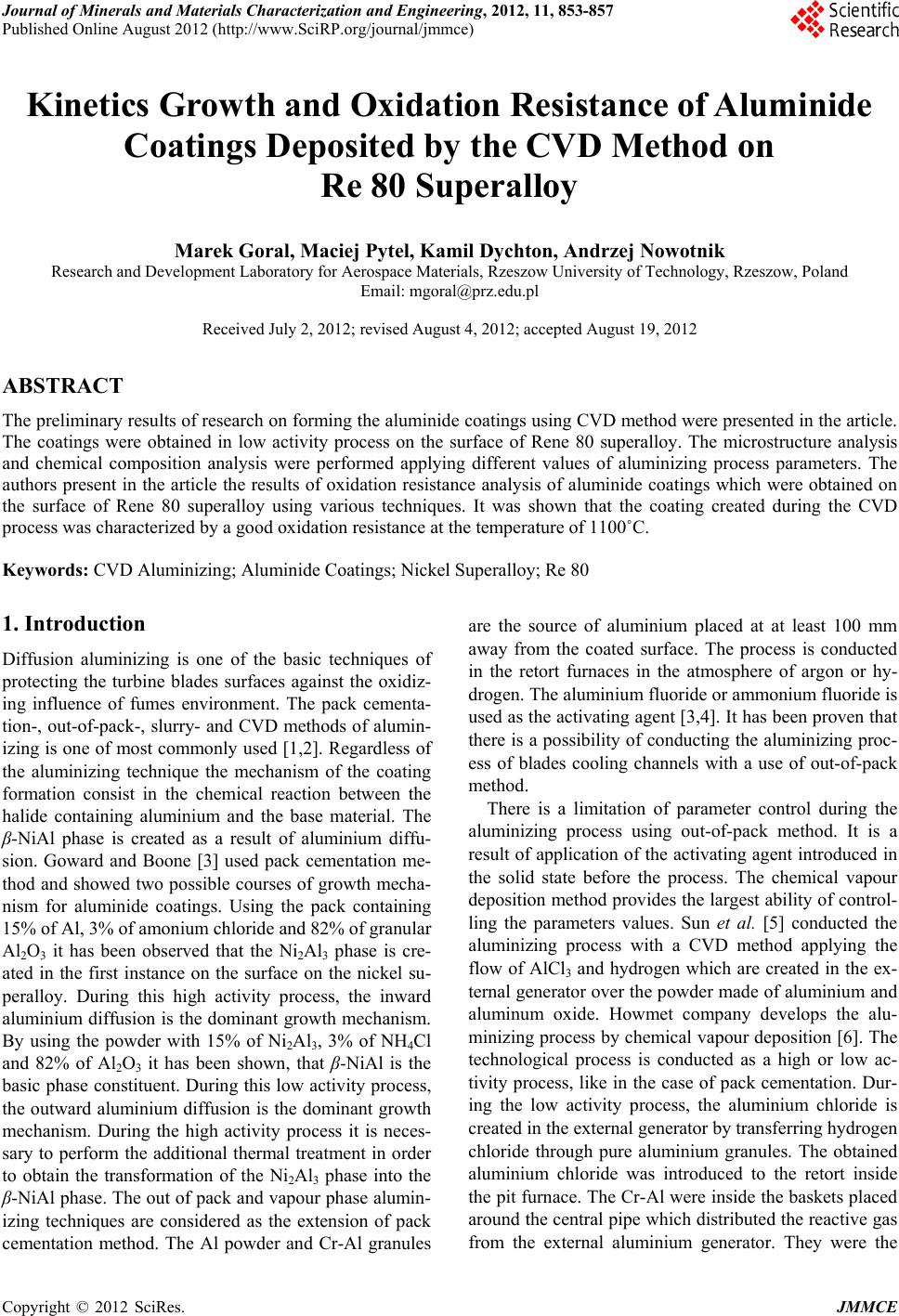
Journal of Minerals and Materials Characterization and Engineering, 2012, 11, 853-857
Published Online August 2012 (http://www.SciRP.org/journal/jmmce)
Kinetics Growth and Oxidation Resistance of Aluminide
Coatings Deposited by the CVD Method on
Re 80 Superalloy
Marek Goral, Maciej Pytel, Kamil Dychton, Andrzej Nowotnik
Research and Development Laboratory for Aerospace Materials, Rzeszow University of Technology, Rzeszow, Poland
Email: mgoral@prz.edu.pl
Received July 2, 2012; revised August 4, 2012; accepted August 19, 2012
ABSTRACT
The preliminary results of research on forming the aluminide coatings using CVD method were presented in the article.
The coatings were obtained in low activity process on the surface of Rene 80 superalloy. The microstructure analysis
and chemical composition analysis were performed applying different values of aluminizing process parameters. The
authors present in the article the results of oxidation resistance analysis of aluminide coatings which were obtained on
the surface of Rene 80 superalloy using various techniques. It was shown that the coating created during the CVD
process was characterized by a good oxidation resistance at the temperature of 1100˚C.
Keywords: CVD Aluminizing; Aluminide Coatings; Nickel Superalloy; Re 80
1. Introduction
Diffusion aluminizing is one of the basic techniques of
protecting the turbine blades surfaces against the oxidiz-
ing influence of fumes environment. The pack cementa-
tion-, out-of-pack-, slurry- and CVD methods of alumin-
izing is one of most commonly used [1,2]. Regardless of
the aluminizing technique the mechanism of the coating
formation consist in the chemical reaction between the
halide containing aluminium and the base material. The
β-NiAl phase is created as a result of aluminium diffu-
sion. Goward and Boone [3] used pack cementation me-
thod and showed two possible courses of growth mecha-
nism for aluminide coatings. Using the pack containing
15% of Al, 3% of amonium chloride and 82% of granular
Al2O3 it has been observed that the Ni2Al3 phase is cre-
ated in the first instance on the surface on the nickel su-
peralloy. During this high activity process, the inward
aluminium diffusion is the dominant growth mechanism.
By using the powder with 15% of Ni2Al3, 3% of NH4Cl
and 82% of Al2O3 it has been shown, that β-NiAl is the
basic phase constituent. During this low activity process,
the outward aluminium diffusion is the dominant growth
mechanism. During the high activity process it is neces-
sary to perform the additional thermal treatment in order
to obtain the transformation of the Ni2Al3 phase into the
β-NiAl phase. The out of pack and vapour phase alumin-
izing techniques are considered as the extension of pack
cementation method. The Al powder and Cr-Al granules
are the source of aluminium placed at at least 100 mm
away from the coated surface. The process is conducted
in the retort furnaces in the atmosphere of argon or hy-
drogen. The aluminium fluoride or ammonium fluoride is
used as the activating agent [3,4]. It has been proven that
there is a possibility of conducting the aluminizing proc-
ess of blades cooling channels with a use of out-of-pack
method.
There is a limitation of parameter control during the
aluminizing process using out-of-pack method. It is a
result of application of the activating agent introduced in
the solid state before the process. The chemical vapour
deposition method provides the largest ability of control-
ling the parameters values. Sun et al. [5] conducted the
aluminizing process with a CVD method applying the
flow of AlCl3 and hydrogen which are created in the ex-
ternal generator over the powder made of aluminium and
aluminum oxide. Howmet company develops the alu-
minizing process by chemical vapour deposition [6]. The
technological process is conducted as a high or low ac-
tivity process, like in the case of pack cementation. Dur-
ing the low activity process, the aluminium chloride is
created in the external generator by transferring hydrogen
chloride through pure aluminium granules. The obtained
aluminium chloride was introduced to the retort inside
the pit furnace. The Cr-Al were inside the baskets placed
around the central pipe which distributed the reactive gas
from the external aluminium generator. They were the
Copyright © 2012 SciRes. JMMCE